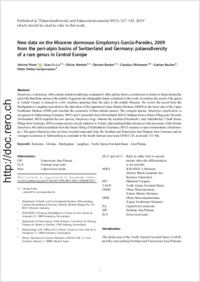New data on the Miocene dormouse Simplomys García-Paredes, 2009 from the peri-alpin basins of Switzerland and Germany: palaeodiversity of a rare genus in Central Europe
- Prieto, Jérôme Department of Earth- and Environmental Science, Palaeontology, Ludwig-Maximilians-University Munich, Germany
- Lu, Xiao-Yu JURASSICA Museum, Porrentruy, Switzerland - Department of Geosciences, Earth Sciences, University of Fribourg, Switzerland
- Maridet, Olivier JURASSICA Museum, Porrentruy, Switzerland - Department of Geosciences, Earth Sciences, University of Fribourg, Switzerland
- Becker, Damien JURASSICA Museum, Porrentruy, Switzerland - Department of Geosciences, Earth Sciences, University of Fribourg, Switzerland
- Pirkenseer, Claudius Department of Geosciences, Earth Sciences, University of Fribourg, Switzerland - Paléontologie A16, Office de la Culture, Porrentruy, Switzerland
- Rauber, Gaëtan Paléontologie A16, Office de la Culture, Porrentruy, Switzerland
- Peláez-Campomanes, Pablo Museo Nacional de Ciencias Naturales, Madrid, Spain
-
01.09.2019
Published in:
- Palaeobiodiversity and Palaeoenvironments. - 2019, vol. 99, no. 3, p. 527–543
English
Simplomys, a dormouse with a simple dental morphology compared to other glirids, shows a continuous evolution in Spain during the end of the Ramblian and up to the middle Aragonian, the stratigraphic frame considered in this work. In contrast, the record of the genus in Central Europe is reduced to a few localities spanning from the early to the middle Miocene. We review the record from the Burdigalian to Langhian equivalent to the deposition of the uppermost Upper Marine Molasse (OMM) to the lower part of the Upper Freshwater Molasse (OSM) and conclude the occurrence of three distinct species. The youngest species, Simplomys simplicidens, is recognised in Schönenberg (Germany, MN5) and Courrendlin-Solé (Switzerland; MN4). Material from a fissure filling near Glovelier (Switzerland, MN4) supplied the new species, Simplomys hugi, whereas the localities Petersbuch 2 and Erkersthofen 2 (both fissure fillings from Germany, MN4) contain species closely related to it. Finally, and pending further advances in the taxonomy of the Iberian Simplomys, the oldest population from the fissure filling of Schnaitheim (Germany; MN3) remains in open nomenclature (Simplomys sp.). The genus Simplomys has not been recorded eastwards from the Swabian and Franconian Jura Plateaus from Germany and its youngest occurrence in Schönenberg is correlated to the South German local scale OSM C+D, at around 15.5 Ma.
- Faculty
- Faculté des sciences et de médecine
- Department
- Département de Géosciences
- Language
-
- English
- Classification
- Palaeontology
- License
-
License undefined
- Identifiers
-
- RERO DOC 327420
- DOI 10.1007/s12549-018-0339-y
- Persistent URL
- https://folia.unifr.ch/unifr/documents/308055
Statistics
Document views: 136
File downloads:
- pdf: 261
